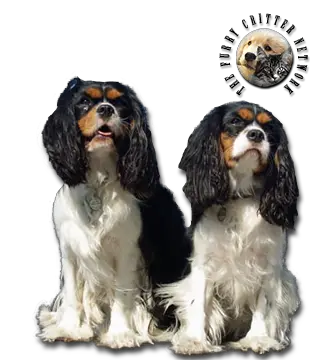Breed Standard
Head: Round. Skull nearly flat. Stop not very pronounced. Cone-shaped muzzle. Strong jaws. Lips not pendulous. Well-developed, black nose.
Ears: Set on high, long. Abundant feathering.
Eyes: Large, round, not protruding, dark.
Body: Long. Neck moderately long, slightly arched. Medium-sized chest. Well-sprung ribs.
Tail: Carried gaily but never much above the topline. Natural or docked by more than one-third.
Hair: Long, silky, not curly. Slightly wavy. Abundant feathering.
Coat: Black and tan (King Charles): raven-black with tan markings above the eyes, on the cheeks, insides of the ears, chest, legs, and underside of the tail. White markings not allowed. - Ruby (the rarest variety): solid, rich red. White markings not allowed. - Blenheim: rich chestnut markings well-distributed over a pearly white ground. Markings should be divided evenly on the head, with a characteristic kissing spot between the ears. - Tricolor (Prince Charles): well-spaced and well-distributed black and white markings with tan markings above the eyes and on the cheeks, insides of the ears, inner legs, and underside of the tail.
Size: 25 to 34 cm.
Weight: 5 to 9 kg.
History
This dog's history is both recent and ancient, since the breed existed by the sixteenth and seventeenth centuries. In 1926, an American dog fancier noticed that today’s King Charles differs from the spaniel depicted in tapestries of yore. British breeders then re-created the ancient toy spaniel that was once a favorite of British kings and princes. Crosses with the King Charles Spaniel, the Pekingese, and the Pug established the first strains of the Cavalier King Charles Spaniel, officially recognized as a breed in 1945. The Cavalier King Charles is stockier and has a longer muzzle than the King Charles Spaniel. The Cavalier King Charles, which has eclipsed the King Charles, is becoming increasingly popular.
Behavior
The breed is highly affectionate, playful, extremely patient and eager to please. As such, dogs of the breed are good with children and other dogs. Cavaliers are not shy about socialising with much larger dogs. They will adapt quickly to almost any environment, family, and location and suit city and country life. Their ability to bond with larger and smaller dogs makes them ideal in houses with more than one breed of dog as long as the other dog is trained. Cavaliers rank 44th in Stanley Coren's The Intelligence of Dogs, being of average intelligence in working or obedience. Cavaliers are naturally curious and playful, but also enjoy simply cuddling up on a cushion or lap, making them excellent companion or lap dogs for medical patients and the elderly.
Cavaliers are active and sporting. Cavaliers are successful in conformation shows, obedience and agility and they also make wonderful therapy dogs due to their sweet, gentle natures. The breed is adaptable in their need for exercise, happy with either sleeping on the couch or taking long walks.
The breed is well known for its loving temperament. They have an instinct to chase most things that move including vehicles on busy streets, and so most Cavaliers will never become "street-wise". As they tend to regard all strangers as friends, members of the breed will usually not make good guard dogs. Spaniels have a strong hunting instinct and may endanger birds and small animals. However, owners have reported that through training their Cavaliers they happily co-exist with a variety of small animals including hamsters and gerbils.
The Cavalier's coat requires weekly brushing, but no trimming. However, some owners prefer to trim their Cavalier's long feathers and slippers that can become very dirty when walking or playing outside.
Function
Pet.
Health
Cavaliers can notably be prone to mitral valve disease, which leads to heart failure. This appears in many Cavaliers at some point in their lives and is the most common cause of death. Some serious genetic health problems, including early-onset mitral valve disease (MVD), the potentially severely painful syringomyelia (SM), hip dysplasia, luxating patellas, and certain vision and hearing disorders are health problems for this breed. As today's Cavaliers all descend from only six dogs, any inheritable disease present in at least one of the original founding dogs can be passed on to a significant proportion of future generations. This is known as the founder effect and is the likely cause of the prevalence of MVD in the breed. Additionally, bad breeding increases the chance that a Cavalier will develop MVD, so it is important to find a responsible breeder who uses dogs with healthy hearts rather than use the first breeder you come across. The health problems shared with this breed include mitral valve disease, luxating patella, and hereditary eye issues such as cataracts and retinal dysplasia. Cavaliers are also affected by ear problems, a common health problem among spaniels of various types, and they can have such other general conditions as hip dysplasia, which are common across many types of dog breeds.






